
- Free Article: No
- Contents Category: Sport
- Custom Article Title: Bernard Whimpress reviews 'Stroke of Genius: Victor Trumper and the shot that changed cricket' by Gideon Haigh
- Book 1 Title: Stroke of Genius
- Book 1 Subtitle: Victor Trumper and the shot that changed cricket
- Book 1 Biblio: Hamish Hamilton $39.99 hb, 332 pp, 9781926428734
George Beldam was a gentleman amateur, a Cambridge graduate before joining his family’s engineering firm, an amateur cricketer, footballer, golfer, painter, and photographer. As an amateur, he played several seasons of first-class cricket, achieved a scratch handicap at golf, and made a deep study of photography, which became his profession. Above all, he was a theorist both playing sport and recording it. His theorising drew him into close association with England’s most famous all-round sportsman, C.B. Fry, over cricket and discussions of aesthetics. It would serve him when photographing the triumvirate of Harry Vardon, James Braid, and J.H. Taylor in Great Golfers: Their Methods at a Glance (1904). His experience as a golf photographer influenced his angle in taking ‘Jumping Out to Drive’ a year later.
Before opening this book, I had great expectations. We all know the adage about a picture being worth a thousand words, and I knew Gideon Haigh was writing a book about the iconic photograph of Trumper. But a whole book? It is a remarkable photo, and Haigh has won a deserved reputation over thirty years, not only for his cricket writing, but also recently for such phenomenal books as The Office (2012) and his real-life crime story, Certain Admissions (2015). If anyone could pen 80,000 words about a single picture, Gideon Haigh could.
Then I read the first chapter. It was too clever by two thirds. The author was trying too hard. Historians care about context, but Haigh was laying on so many layers: history of cricket, history of cricket in art, history of cricket in photography, history of cricket in journalism, history of images of Australian Indigenous cricketers, discussion of amateurs versus professionals. I began to think a better title for the book would be ‘Everything you wanted to know about Victor Trumper jumping out to drive but were afraid to ask.’ Why afraid? Because Haigh might tell you.
 Australian cricketer Victor Trumper 'jumping out for a straight drive' (photograph by George Bedlam, National Portrait Gallery/Wikimedia Commons)
Australian cricketer Victor Trumper 'jumping out for a straight drive' (photograph by George Bedlam, National Portrait Gallery/Wikimedia Commons)
I took a break for a week. I came back and I am glad I did. The book embraces myriad aspects of Trumper – the aesthete, the incarnation of Australian possibility, the subject suitable for artistic representation, the myths and legend – and these are well developed. Haigh calls many witnesses – Fry, J.C. Davis, Leslie Poidevin, Neville Cardus, Arthur Mailey, Eric Barbour, Jack Fingleton, ‘Doc’ Evatt, C.L.R. James, Dal Stivens, even Kevin Rudd; some who saw Trumper in their mature years, some in boyhood who rhapsodised about him ever after, some who never saw him but wished they had. In the end, Haigh makes his own judgments, and these are typically forceful and elegantly, even euphoniously, expressed, as in the following example responding to a Mailey newspaper article comparing Trumper and Bradman:
Bradman brought out, in fact, a certain unevolved Victorianism of cricket’s aesthetic. His scores, huge, repetitive, homogenous seemed distastefully out of proportion, almost inhuman: had Ruskin not warned that ‘to banish imperfection is to destroy expression, to check exertion, to paralyse vitality’? Confronted by the objective reality of Bradman’s runs, an elite of critics found grounds for subjective dispute, reasserting other criteria of evaluation: beauty, audacity, capacity in adversity, skill on poor wickets. Bradman quickly overshadowed Trumper’s runs and steadily occluded his reputation. Yet in another respect, Bradman also ensured Trumper a continued relevance, as a counterpoint, as an alternative.
If I have one quibble, it is with the book’s subtitle. Did Trumper’s shot change cricket, or was it Beldam’s image that changed the way the game was seen? For readers, Stroke of Genius offers such numerous fresh perspectives about cricket that it is a stroke of genius itself.


Comments powered by CComment